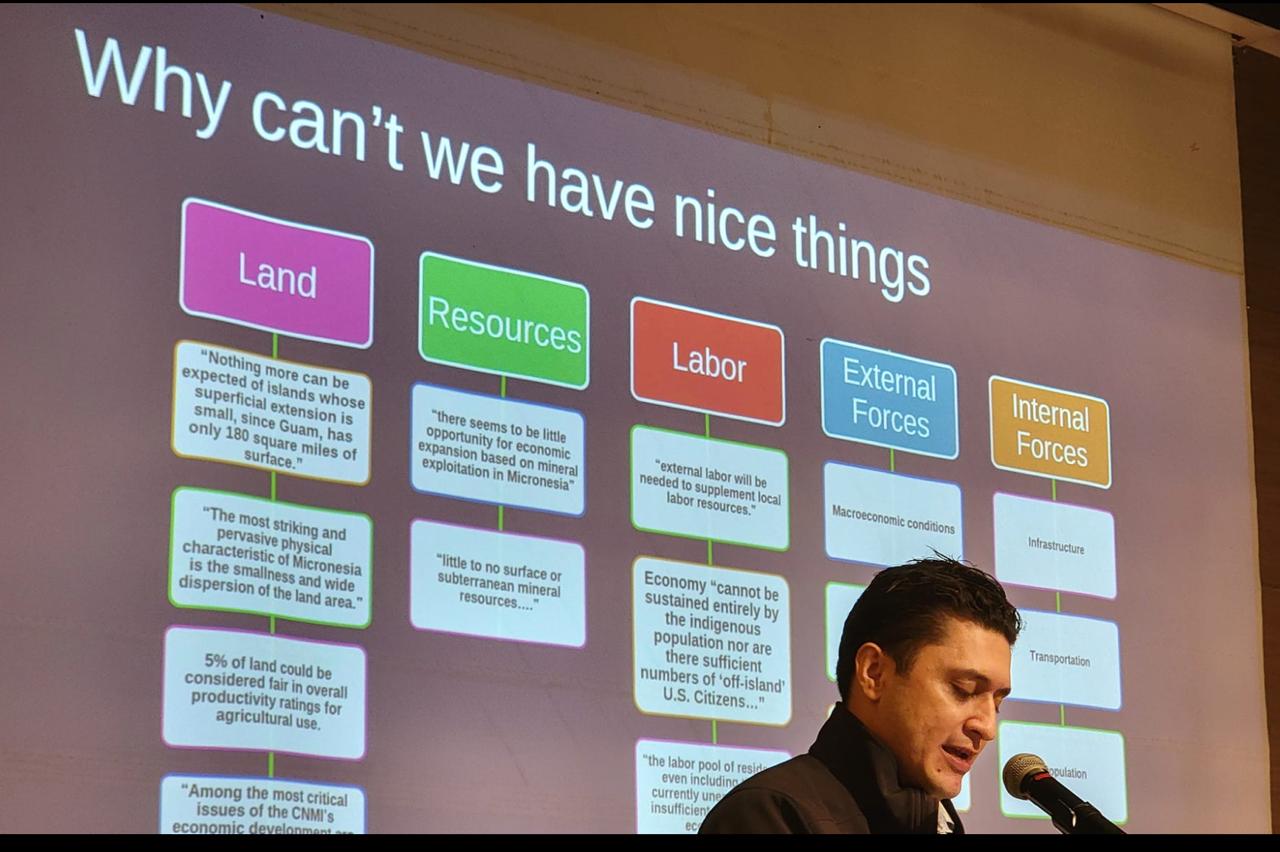
Local economist Matthew Deleon Guerrero at the Saipan Chamber of Commerce’s 2nd Economic Summit last week.
IN his presentation at the Saipan Chamber of Commerce’s 2nd Economic Summit last week, local economist Matthew Deleon Guerrero explained why the loss of tourist arrivals “translates into broader economic discontent,” and why renewed efforts to diversify the economy “without fully recognizing/addressing the challenges of economic development” in small, remote typhoon-prone islands with a small (and shrinking) population will fall short, again.
Tourist arrivals and the hotel occupancy rates are still down compared to their pre-pandemic levels. We all know that. But some, including certain CNMI officials, seem unaware of the connection between the dismal tourism numbers and the government’s paltry revenue.
“Tourism is really big,” Matt reminds us. Citing official figures, he said 54% of customers in the CNMI were tourists. Households accounted for 15% of the total number; construction contractors, 4%; the CNMI government, 4%; the federal government, 1%; and all other classes of customers, 22%.
He then mentioned key historical and socio-economic facts that, by now, should be well-known to CNMI leaders and politicians. Like this observation made by University of Hawaii Professor Donald D. Johnson in 1970:
“The hard fact is that without outside economic assistance the Trust Territory [which included the Northern Marianas] has little prospect of achieving and maintaining nationhood in today’s world. The mineral resource of the islands offers no adequate base for a modern national economy…. The soil of the area is insufficient to offer the prospect of a thriving, agricultural-based economy…. The major hope for economic advancement in the area in the near future seems to lie in tourism, military base or other types of change which will demand large increases in foreign investment….”
And then there’s the perennial need for an adequate workforce, which, according to the unfortunately uninformed or the willfully misinformed, can be created locally through higher wages and training. That’s how the U.S., Canada, Japan, Britain and many other countries with large populations have tried to “solve” their labor shortages, which continue to persist, and could have been much worse without foreign workers.
Matt mentioned the following statements made, through the years, by experts who have looked into the local economy:
• “External labor will be needed to supplement local labor resources.”
• The economy “cannot be sustained entirely by the indigenous population nor are there sufficient numbers of ‘off-island’ U.S. Citizens….”
• “The labor pool of residents, even including those currently unemployed, is insufficient to support an economy…”
Matt also noted the existence of at least five economic plans or studies pertaining to the Northern Marianas:
1) A 1977 socioeconomic development plan that recommended agriculture, fishing, manufacturing, construction, services and tourism.
2) The 1989 “Prospectus for Guiding Growth” in the “exploitation of marine resources, fisheries, furniture, handicrafts, pharmaceuticals.”
3) The 1999 NMC Economic Study, which proposed financial services, captive insurance, telecommunications, data processing, software production, specialty agriculture, retirement villages, telemarketing.
4) The 2003 BOH Economic Report, which focused on ecotourism and higher education.
5) The 2007 CNMI Business Opportunities Report, which suggested education, agriculture, aquaculture and the film industry.
According to Variety news files, there had been discussions to diversify the local economy even before tourism became the island’s main industry. The list of possible new businesses or industries that the CNMI should consider continues to grow, but as Matt pointed out, quoting the 1999 NMC Economic Study, new industries, with few exceptions, “will take time to develop. In most cases this means a number of years. Therefore, they will not provide the ‘quick fix’ that may be needed in the near-term to mitigate the economic and political difficulties that the CNMI is currently facing. Nevertheless, decision regarding which of these industries should be pursued and actions designated to attract them should commence immediately. Otherwise, the CNMI may find itself in a downturn once again in several years, without having performed the preliminary work to protect against recession.”
In fairness to the then-administration and Legislature, they did enact several pieces of legislation creating, among other things, a tax incentive program and free trade zones that aimed to attract new industries. The next administration, for its part, tried to transform NMC into an edu-tourism center, and, to diversify the CNMI’s tourism market, successfully sought an “Approved Destination Status” from China in 2004.
But again, all of that required time. In the case of the China tourism market, it took about nine years before annual arrivals exceeded 100,000. As for the tax incentive program and free trade zones, the loss of local control over immigration and minimum has imposed significant restrictions on potential investors.
We should also remember that the Commonwealth boom years ended in 1998, and that the local economy would not recover until about 2012 when the arrival rate finally began improving. It would continue to increase annually until 2018 before collapsing during the Covid years. Moreover, before IPI self-destructed, it was providing revenue that funded the CNMI government’s annual $30 million – $45 million payments to the Settlement Fund. This prevented the collapse of the local retirement system and allowed the CNMI government to fund its other obligations, including the retirees’ 25% benefit.
But Yutu happened. And then Covid-19. Today, instead of welcoming new investors, the CNMI is saying goodbye to long-time businesses like the Hyatt. The Japanese tourist market is a drop in a bucket full of holes. There are still no direct flights from mainland China. The Korean tourist arrivals are not enough to keep all hotels afloat.
Matt’s advice?
He quoted Theodore Roosevelt, who once said, “Do what you can, with what you have, where you are.”
That should be a good starting point for policy makers. And it should include the recommendations of the Saipan Chamber of Commerce and HANMI, which for over half a year now, have been imploring the CNMI leadership to take specific actions that could stop the bleeding.
Send feedback to editor@mvariety.com











